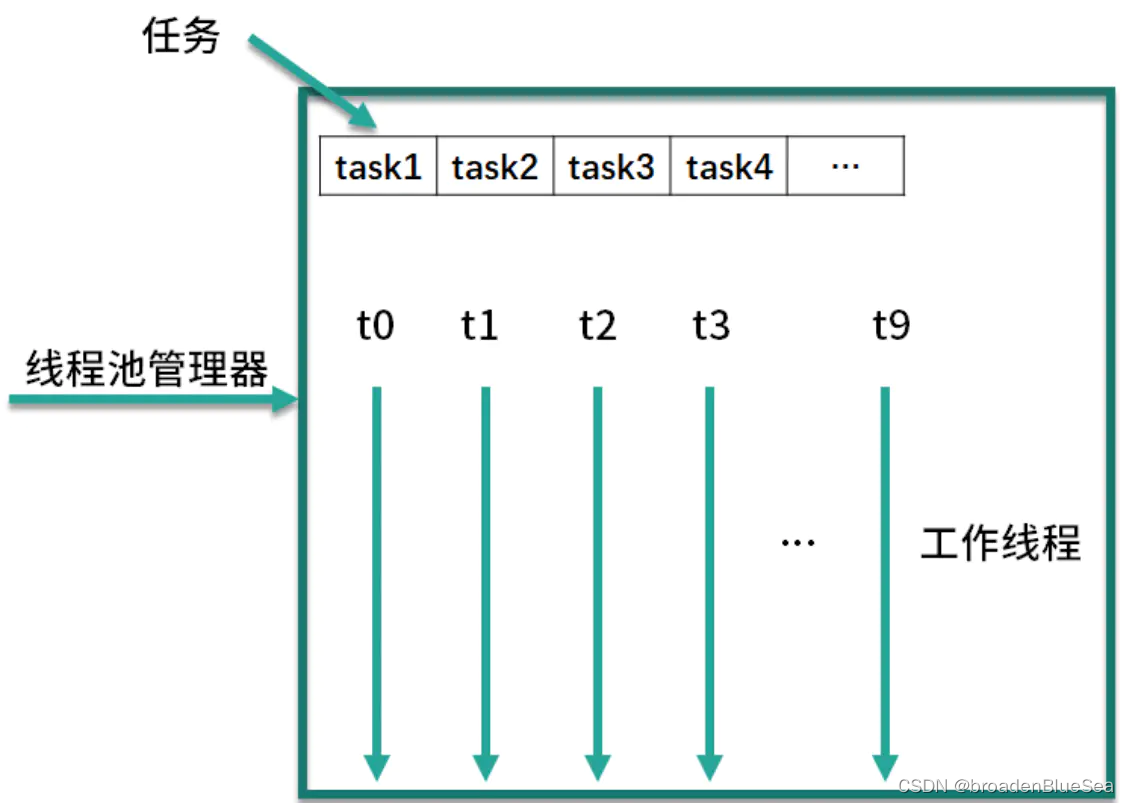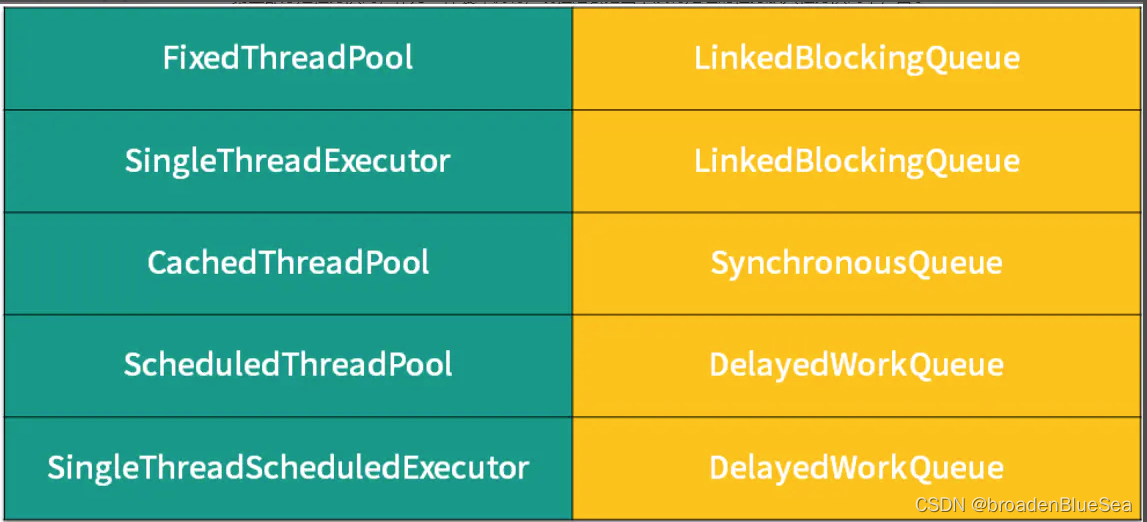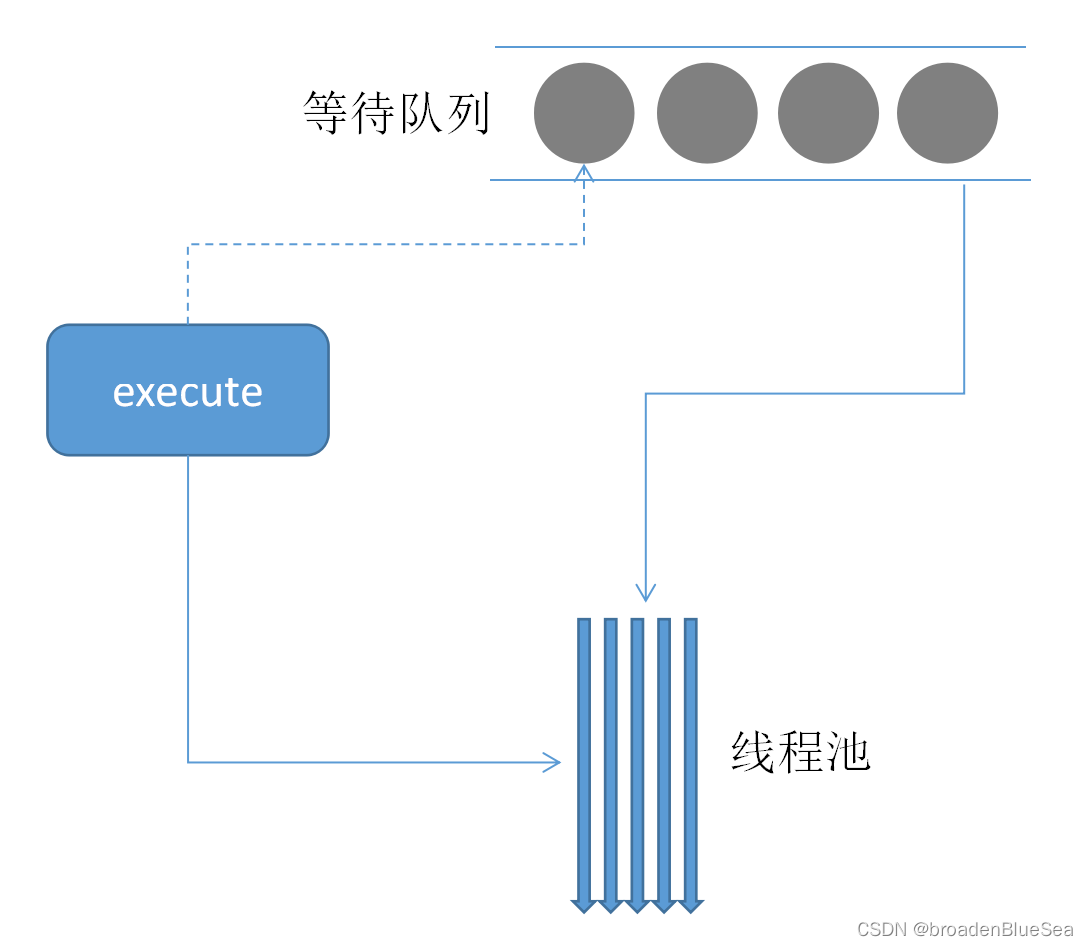线程池的内部结构
-
使⽤线程池的原因:
1、降低资源消耗
2、控制并发的数量。并发数量过多,可能会导致资源消耗过多,从⽽造成服务器崩溃
3、提高线程的可管理性
1、线程是稀缺资源,如果无限制地创建,不仅会消耗系统资源,还会降低系统的稳定性,使用线程池可以进行统一分配、调优和监控。
4、提高响应速度
1、当任务到达时,任务可以不需要等到线程创建就能立即执行。
1、线程池的结构
> 1、线程池的内部结构主要由四部分组成
>> 1、第一部分是线程池管理器,它主要负责管理线程池的创建、销毁、添加任务等管理操作,它是整个线程池的管家。
>> 2、第二部分是工作线程,也就是图中的线程 t0~t9,这些线程勤勤恳恳地从任务队列中获取任务并执行。
>> 3、第三部分是任务队列,作为一种缓冲机制,线程池会把当下没有处理的任务放入任务队列中,由于多线程同时从任务队列中获取任务是并发场景,此时就需要任务队列满足线程安全的要求,所以线程池中任务队列采用 BlockingQueue 来保障线程安全。
>> 4、 第四部分是任务,任务要求实现统一的接口,以便工作线程可以处理和执行。

2、阻塞队列
3、线程池中的这四个主要组成部分最值得我们关注的就是阻塞队列了,如表格所示,不同的线程池会选用不同的阻塞队列。
- LinkedBlockingQueue
1、对于 FixedThreadPool 和 SingleThreadExector 而言,它们使用的阻塞队列是容量为 Integer.MAX_VALUE 的 LinkedBlockingQueue,可以认为是无界队列。由于 FixedThreadPool 线程池的线程数是固定的,所以没有办法增加特别多的线程来处理任务,这时就需要 LinkedBlockingQueue 这样一个没有容量限制的阻塞队列来存放任务。这里需要注意,由于线程池的任务队列永远不会放满,所以线程池只会创建核心线程数量的线程,所以此时的最大线程数对线程池来说没有意义,因为并不会触发生成多于核心线程数的线程。
- SynchronousQueue
1、第二种阻塞队列是 SynchronousQueue,对应的线程池是 CachedThreadPool。线程池 CachedThreadPool 的最大线程数是 Integer 的最大值,可以理解为线程数是可以无限扩展的。CachedThreadPool 和上一种线程池 FixedThreadPool 的情况恰恰相反,FixedThreadPool 的情况是阻塞队列的容量是无限的,而这里 CachedThreadPool 是线程数可以无限扩展,所以 CachedThreadPool 线程池并不需要一个任务队列来存储任务,因为一旦有任务被提交就直接转发给线程或者创建新线程来执行,而不需要另外保存它们。
- DelayedWorkQueue
1、第三种阻塞队列是DelayedWorkQueue,它对应的线程池分别是 ScheduledThreadPool 和 SingleThreadScheduledExecutor,这两种线程池的最大特点就是可以延迟执行任务,比如说一定时间后执行任务或是每隔一定的时间执行一次任务。DelayedWorkQueue 的特点是内部元素并不是按照放入的时间排序,而是会按照延迟的时间长短对任务进行排序,内部采用的是“堆”的数据结构。之所以线程池 ScheduledThreadPool 和 SingleThreadScheduledExecutor 选择 DelayedWorkQueue,是因为它们本身正是基于时间执行任务的,而延迟队列正好可以把任务按时间进行排序,方便任务的执行
2、线程池的原理
1、线程池的基本结构,如下图所示。用户通过使用线程池的execute方法将Runnable提交到线程池中进行执行。当线程池中的线程都很忙的时候,这个新加入的 Runnable 就会被放到等待队列。当线程空闲下来的时候,就会去等待队列里查看是否还有排队等待的任务,如果有,就会队列中取出任务并继续执行。如果没有,线程就会进入休眠。
2、如果我们更具体一点,就以本周第二节课所讲的ThreadPoolExecutor为例。当我们把一个Runnable交给线程池去执行的时候,这个线程池处理的流程是这样的:
2.1、先判断线程池中的核心线程们是否空闲,如果空闲,就把这个新的任务指派给某一个空闲线程去执行。如果没有空闲,并且当前线程池中的核心线程数还小于 corePoolSize,那就再创建一个核心线程。
2.2、果线程池的线程数已经达到核心线程数,并且这些线程都繁忙,就把这个新来的任务放到等待队列中去。如果等待队列又满了,那么查看一下当前线程数是否到达maximumPoolSize,如果还未到达,就继续创建线程。如果已经到达了,就交给RejectedExecutionHandler来决定怎么处理这个任务。
public void execute(Runnable command) {
if (command == null)
throw new NullPointerException();
int c = ctl.get();
if (workerCountOf(c) < corePoolSize) {
if (addWorker(command, true))
return;
c = ctl.get();
}
if (isRunning(c) && workQueue.offer(command)) {
int recheck = ctl.get();
if (! isRunning(recheck) && remove(command))
reject(command);
else if (workerCountOf(recheck) == 0)
addWorker(null, false);
}
else if (!addWorker(command, false))
reject(command);
}
- Java中的线程池是用ThreadPoolExecutor类来实现的,先看一下线程池的类图:

2.1、线程池的创建
public ThreadPoolExecutor(int corePoolSize,
int maximumPoolSize,
long keepAliveTime,
TimeUnit unit,
BlockingQueue<Runnable> workQueue) {
this(corePoolSize, maximumPoolSize, keepAliveTime, unit, workQueue,
Executors.defaultThreadFactory(), defaultHandler);
}
public ThreadPoolExecutor(int corePoolSize,
int maximumPoolSize,
long keepAliveTime,
TimeUnit unit,
BlockingQueue<Runnable> workQueue,
ThreadFactory threadFactory) {
this(corePoolSize, maximumPoolSize, keepAliveTime, unit, workQueue,
threadFactory, defaultHandler);
}
public ThreadPoolExecutor(int corePoolSize,
int maximumPoolSize,
long keepAliveTime,
TimeUnit unit,
BlockingQueue<Runnable> workQueue,
RejectedExecutionHandler handler) {
this(corePoolSize, maximumPoolSize, keepAliveTime, unit, workQueue,
Executors.defaultThreadFactory(), handler);
}
public ThreadPoolExecutor(int corePoolSize,
int maximumPoolSize,
long keepAliveTime,
TimeUnit unit,
BlockingQueue<Runnable> workQueue,
ThreadFactory threadFactory,
RejectedExecutionHandler handler) {
if (corePoolSize < 0 ||
maximumPoolSize <= 0 ||
maximumPoolSize < corePoolSize ||
keepAliveTime < 0)
throw new IllegalArgumentException();
if (workQueue == null || threadFactory == null || handler == null)
throw new NullPointerException();
this.corePoolSize = corePoolSize;
this.maximumPoolSize = maximumPoolSize;
this.workQueue = workQueue;
this.keepAliveTime = unit.toNanos(keepAliveTime);
this.threadFactory = threadFactory;
this.handler = handler;
}
参数介绍
创建线程池需要以下几个参数,其中有5个是必需的:
1、corePoolSize(必需):核心线程数。默认情况下,核心线程会一直存活,但是当将 allowCoreThreadTimeout 设置为 true 时,核心线程也会超时回收。
2、maximumPoolSize(必需):线程池所能容纳的最大线程数。当活跃线程数达到该数值后,后续的新任务将会阻塞。
3、keepAliveTime(必需):线程闲置超时时长。如果超过该时长,非核心线程就会被回收。如果将 allowCoreThreadTimeout 设置为 true 时,核心线程也会超时回收。
4、unit(必需):指定 keepAliveTime 参数的时间单位。常用的有:TimeUnit.MILLISECONDS(毫秒)、TimeUnit.SECONDS(秒)、TimeUnit.MINUTES(分)。
5、workQueue(必需):任务队列。通过线程池的 execute() 方法提交的 Runnable 对象将存储在该参数中。其采用阻塞队列实现。
6、threadFactory(可选):线程工厂。用于指定为线程池创建新线程的方式。
7、handler(可选):拒绝策略。当达到最大线程数时需要执行的饱和策略。
2.2、使用线程池
// 创建线程池
ThreadPoolExecutor threadPool = new ThreadPoolExecutor(CORE_POOL_SIZE, MAXIMUM_POOL_SIZE, KEEP_ALIVE, TimeUnit.SECONDS, sPoolWorkQueue, sThreadFactory);
// 向线程池提交任务
threadPool.execute(new Runnable() {
@Override
public void run() {
... // 线程执行的任务
}
});
// 关闭线程池
threadPool.shutdown(); // 设置线程池的状态为SHUTDOWN,然后中断所有没有正在执行任务的线程
threadPool.shutdownNow(); // 设置线程池的状态为 STOP,然后尝试停止所有的正在执行或暂停任务的线程,并返回等待执行任务的列表
2.3、线程池原理
- 下面来描述一下线程池工作的原理,同时对上面的参数有一个更深的了解。其工作原理流程图如下:

2.4、线程池的参数
2.4.1、任务队列(workQueue)
- 任务队列是基于阻塞队列实现的,即采用生产者消费者模式,在 Java 中需要实现 BlockingQueue 接口。但 Java 已经为我们提供了 7 种阻塞队列的实现:
1、ArrayBlockingQueue:一个由数组结构组成的有界阻塞队列(数组结构可配合指针实现一个环形队列)。
LinkedBlockingQueue: 一个由链表结构组成的有界阻塞队列,在未指明容量时,容量默认为 Integer.MAX_VALUE。
2、PriorityBlockingQueue: 一个支持优先级排序的无界阻塞队列,对元素没有要求,可以实现 Comparable 接口也可以提供 Comparator 来对队列中的元素进行比较。跟时间没有任何关系,仅仅是按照优先级取任务。
3、DelayQueue:类似于PriorityBlockingQueue,是二叉堆实现的无界优先级阻塞队列。要求元素都实现 Delayed 接口,通过执行时延从队列中提取任务,时间没到任务取不出来。
4、SynchronousQueue: 一个不存储元素的阻塞队列,消费者线程调用 take() 方法的时候就会发生阻塞,直到有一个生产者线程生产了一个元素,消费者线程就可以拿到这个元素并返回;生产者线程调用 put() 方法的时候也会发生阻塞,直到有一个消费者线程消费了一个元素,生产者才会返回。
5、LinkedBlockingDeque: 使用双向队列实现的有界双端阻塞队列。双端意味着可以像普通队列一样 FIFO(先进先出),也可以像栈一样 FILO(先进后出)。
6、LinkedTransferQueue: 它是ConcurrentLinkedQueue、LinkedBlockingQueue 和 SynchronousQueue 的结合体,但是把它用在 ThreadPoolExecutor 中,和 LinkedBlockingQueue 行为一致,但是是无界的阻塞队列。
- 注意有界队列和无界队列的区别:如果使用有界队列,当队列饱和时并超过最大线程数时就会执行拒绝策略;而如果使用无界队列,因为任务队列永远都可以添加任务,所以设置maximumPoolSize 没有任何意义
2.5、线程工厂(threadFactory)
1、线程工厂指定创建线程的方式,需要实现 ThreadFactory 接口,并实现 newThread(Runnable r) 方法。该参数可以不用指定,Executors 框架已经为我们实现了一个默认的线程工厂:
/**
* The default thread factory.
*/
private static class DefaultThreadFactory implements ThreadFactory {
private static final AtomicInteger poolNumber = new AtomicInteger(1);
private final ThreadGroup group;
private final AtomicInteger threadNumber = new AtomicInteger(1);
private final String namePrefix;
DefaultThreadFactory() {
SecurityManager s = System.getSecurityManager();
group = (s != null) ? s.getThreadGroup() :
Thread.currentThread().getThreadGroup();
namePrefix = "pool-" +
poolNumber.getAndIncrement() +
"-thread-";
}
public Thread newThread(Runnable r) {
Thread t = new Thread(group, r,
namePrefix + threadNumber.getAndIncrement(),
0);
if (t.isDaemon())
t.setDaemon(false);
if (t.getPriority() != Thread.NORM_PRIORITY)
t.setPriority(Thread.NORM_PRIORITY);
return t;
}
}
2.6、拒绝策略(handler)
- 当线程池的线程数达到最大线程数时,需要执行拒绝策略。拒绝策略需要实现 RejectedExecutionHandler 接口,并实现 rejectedExecution(Runnable r, ThreadPoolExecutor executor) 方法。不过 Executors 框架已经为我们实现了 4 种拒绝策略:
1、AbortPolicy(默认):丢弃任务并抛出RejectedExecutionException 异常。
2、CallerRunsPolicy:由调用线程处理该任务。
3、DiscardPolicy:丢弃任务,但是不抛出异常。可以配合这种模式进行自定义的处理方式。
4、DiscardOldestPolicy:丢弃队列最早的未处理任务,然后重新尝试执行任务。
2.5、功能线程池
- 定长线程池(FixedThreadPool)
- 定时线程池(ScheduledThreadPool )
- 可缓存线程池(CachedThreadPool)
- 单线程化线程池(SingleThreadExecutor)
2.5.1、定长线程池(FixedThreadPool)
- 源码
public static ExecutorService newFixedThreadPool(int nThreads) {
return new ThreadPoolExecutor(nThreads, nThreads,
0L, TimeUnit.MILLISECONDS,
new LinkedBlockingQueue<Runnable>());
}
public static ExecutorService newFixedThreadPool(int nThreads, ThreadFactory threadFactory) {
return new ThreadPoolExecutor(nThreads, nThreads,
0L, TimeUnit.MILLISECONDS,
new LinkedBlockingQueue<Runnable>(),
threadFactory);
}
特点:只有核心线程,线程数量固定,执行完立即回收,任务队列为链表结构的有界队列。
应用场景:控制线程最大并发数
- 使用示例:
// 1. 创建定长线程池对象 & 设置线程池线程数量固定为3
ExecutorService fixedThreadPool = Executors.newFixedThreadPool(3);
// 2. 创建好Runnable类线程对象 & 需执行的任务
Runnable task =new Runnable(){
public void run() {
System.out.println("执行任务啦");
}
};
// 3. 向线程池提交任务
fixedThreadPool.execute(task);
2.5.2、定时线程池(ScheduledThreadPool )
- 源码
private static final long DEFAULT_KEEPALIVE_MILLIS = 10L;
public static ScheduledExecutorService newScheduledThreadPool(int corePoolSize) {
return new ScheduledThreadPoolExecutor(corePoolSize);
}
public ScheduledThreadPoolExecutor(int corePoolSize) {
super(corePoolSize, Integer.MAX_VALUE,
DEFAULT_KEEPALIVE_MILLIS, MILLISECONDS,
new DelayedWorkQueue());
}
public static ScheduledExecutorService newScheduledThreadPool(
int corePoolSize, ThreadFactory threadFactory) {
return new ScheduledThreadPoolExecutor(corePoolSize, threadFactory);
}
public ScheduledThreadPoolExecutor(int corePoolSize,
ThreadFactory threadFactory) {
super(corePoolSize, Integer.MAX_VALUE,
DEFAULT_KEEPALIVE_MILLIS, MILLISECONDS,
new DelayedWorkQueue(), threadFactory);
}
特点:核心线程数量固定,非核心线程数量无限,执行完闲置 10ms 后回收,任务队列为延时阻塞队列。
应用场景:执行定时或周期性的任务。
- 使用实例
// 1. 创建 定时线程池对象 & 设置线程池线程数量固定为5
ScheduledExecutorService scheduledThreadPool = Executors.newScheduledThreadPool(5);
// 2. 创建好Runnable类线程对象 & 需执行的任务
Runnable task =new Runnable(){
public void run() {
System.out.println("执行任务啦");
}
};
// 3. 向线程池提交任务
scheduledThreadPool.schedule(task, 1, TimeUnit.SECONDS); // 延迟1s后执行任务
scheduledThreadPool.scheduleAtFixedRate(task,10,1000,TimeUnit.MILLISECONDS);// 延迟10ms后、每隔1000ms执行任务
2.5.3、可缓存线程池(CachedThreadPool)
- 源码
public static ExecutorService newCachedThreadPool() {
return new ThreadPoolExecutor(0, Integer.MAX_VALUE,
60L, TimeUnit.SECONDS,
new SynchronousQueue<Runnable>());
}
public static ExecutorService newCachedThreadPool(ThreadFactory threadFactory) {
return new ThreadPoolExecutor(0, Integer.MAX_VALUE,
60L, TimeUnit.SECONDS,
new SynchronousQueue<Runnable>(),
threadFactory);
}
特点:无核心线程,非核心线程数量无限,执行完闲置 60s 后回收,任务队列为不存储元素的阻塞队列。
应用场景:执行大量、耗时少的任务。
- 使用实例
// 1. 创建可缓存线程池对象
ExecutorService cachedThreadPool = Executors.newCachedThreadPool();
// 2. 创建好Runnable类线程对象 & 需执行的任务
Runnable task =new Runnable(){
public void run() {
System.out.println("执行任务啦");
}
};
// 3. 向线程池提交任务
cachedThreadPool.execute(task);
2.5.4、单线程化线程池(SingleThreadExecutor)
- 源码
public static ExecutorService newSingleThreadExecutor() {
return new FinalizableDelegatedExecutorService
(new ThreadPoolExecutor(1, 1,
0L, TimeUnit.MILLISECONDS,
new LinkedBlockingQueue<Runnable>()));
}
public static ExecutorService newSingleThreadExecutor(ThreadFactory threadFactory) {
return new FinalizableDelegatedExecutorService
(new ThreadPoolExecutor(1, 1,
0L, TimeUnit.MILLISECONDS,
new LinkedBlockingQueue<Runnable>(),
threadFactory));
}
特点:只有 1 个核心线程,无非核心线程,执行完立即回收,任务队列为链表结构的有界队列。
应用场景:不适合并发但可能引起 IO 阻塞性及影响 UI 线程响应的操作,如数据库操作、文件操作等。
- 实例
// 1. 创建单线程化线程池
ExecutorService singleThreadExecutor = Executors.newSingleThreadExecutor();
// 2. 创建好Runnable类线程对象 & 需执行的任务
Runnable task =new Runnable(){
public void run() {
System.out.println("执行任务啦");
}
};
// 3. 向线程池提交任务
singleThreadExecutor.execute(task);
2.5.5、对比

2.6、总结
1、Executors 的 4 个功能线程池虽然方便,但现在已经不建议使用了,而是建议直接通过使用 ThreadPoolExecutor 的方式,这样的处理方式让写的同学更加明确线程池的运行规则,规避资源耗尽的风险。
2、FixedThreadPool 和 SingleThreadExecutor:主要问题是堆积的请求处理队列均采用 LinkedBlockingQueue,可能会耗费非常大的内存,甚至 OOM。
3、CachedThreadPool 和 ScheduledThreadPool:主要问题是线程数最大数是 Integer.MAX_VALUE,可能会创建数量非常多的线程,甚至 OOM。
























 332
332











 被折叠的 条评论
为什么被折叠?
被折叠的 条评论
为什么被折叠?








